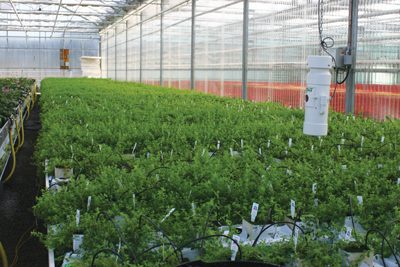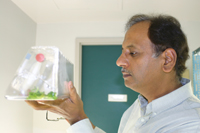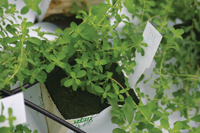
The natural medicine industry has bloomed from its niche market roots to the multibillion-dollar industry it is today.
The natural medicine industry has bloomed from its niche market roots to the multibillion-dollar industry it is today. Yet, despite plant-based supplements and medicines becoming increasingly mainstream, relatively little is known about what effects they have on human health. For that matter, very little is known about how to properly cultivate and reap the rewards of their medicinal properties.
 |
|
| St. John’s wort is known as “nature’s Prozac. Advertisement
|
But University of Guelph researcher Praveen Saxena wants to change all that. His latest work combines the use of tissue culture and controlled environment greenhouses to mass-produce several different medicinal plant varieties that are legendary in traditional Indian Ayurvedic medicine.
Ayurvedic medicine uses thousands of years of ancient botanical and medicinal knowledge to give its practitioners the ability to select the most effective plant or combination of plants for disease prevention (in the western world, most medicines are taken for treatment rather than prevention).
PLANTS A NATURAL WAY TO FIGHT SIGNS OF AGING AND REDUCE STRESS
■ Saxena says plants can be a natural way for people to fight the signs of aging, boost their immune systems, reduce stress, combat depression and prevent the progression of aging and related neurological disorders.
He believes the greenhouse industry could benefit greatly by applying this ancient knowledge to modern greenhouse settings. But first, greenhouse producers must be sure that the medicinal plants grown in their controlled environments are safe and effective.
“The plant is often the most neglected part of herbal medicine because people really don’t pay attention to the botany, the physiology or the genealogy,” he says. “A full understanding of the medicinal plants themselves is required to produce a high quality product.”
Many of these medicinal plants have been used in the eastern world for well over 1,000 years. Only in the last two decades have they slowly started making their way overseas to Canadian greenhouses.
SOME PLANTS SHOWN TO IMPROVE BRAIN FUNCTIONS
■ One such plant being cultivated by Saxena is Tulsi or Holy Basil, a plant that has been used for thousands of years in sacred cultural and spiritual practices. Nowadays, it has a more clinical function; research has shown that Tusli, along with many other plants popularly referred to as “brain tonic,” can help to improve brain functions and possibly delay the onset of neurological diseases such as Alzheimer’s.
 |
|
| Dr. Praveen Saxena
|
“If the greenhouse industry starts growing these plants to become part of a regular diet, it could be a really positive thing,” says Saxena. “People’s enthusiasm in holistic lifestyle is increasing rapidly and they are starting to wake up to using medicinal plants.”
Much of the time, a plant’s medicinal content is drawn from the phytochemicals it releases as a natural repellant or defence against insects and other predators. But in a natural field setting, no two plants are chemically identical. That means the amount of a desirable medicinal compound could vary widely among the plants.
TISSUE CULTURE HELPS REPLICATE PLANTS WITH BEST CHARACTERISTICS
■ However, through cloning and tissue culture growth within controlled greenhouse environments, Saxena is able to select elite individual plants that are found to have the most desirable characteristics. Then, using tissue culture from a root or leaf, he can generate thousands of genetically identical plants that are then grown in his greenhouses, with each plant producing near-identical amounts of medicinal compounds.
Among many medicinal plants from different parts of the globe that Saxena’s Cell Technology Lab is mass-producing is St. John’s wort, also known as “nature’s Prozac,” whose contents can help ease depression.
In a greenhouse environment, Saxena is able to grow thousands of St. John’s wort plants in 10 to 14 weeks, compared to the one or two years they would require in the field. Saxena makes adjustments to the greenhouse temperature and plants’ feed to continue growing and harvesting them over the winter months, well outside of their typically short May through August growing season.
 |
|
| A closeup of St. John’s wort, one of the world’s most popular medicinal plants.
|
These adjustable environments also give Saxena and his students control over the plant’s growth cycle that they wouldn’t have in a natural setting. For example, if a plant has the maximum amount of a certain medicinal chemical during its flowering stage, they can make changes to the plant’s greenhouse environment by manipulating light, temperature, nutrients or carbon dioxide gas to speed up the plant’s growth and its medicinal content.
And thanks to the rich literature on Ayurvedic medicine, the best time to harvest, process and eat certain plants for the best results has already been established.
GREENHOUSES PROVIDE OPTIMAL GROWING CONDITIONS
■ However, just because a plant-based medicine claims to be “natural” doesn’t mean it’s always safe. For example, a wild plant that carries a disease or has accumulated toxic metals and is then powdered and processed could be a serious health hazard.
But controlled greenhouse environments provide a contamination-free and sterile environment where growers can continue to safely and gradually introduce new medicinal plant varieties to a North American audience.
“Medicinal plants are a big business and it can be very profitable,” says Saxena. “The key lies in the fact that we need to introduce novel plants that have been proven safe over a period of time in many cultures and populations with proven benefits.”
Saxena’s research receives funding from the Natural Sciences and Engineering Research Council as well as the Ontario Research Fund.
Joey Sabljic is a writer with the SPARK (Students Promoting Awareness of Research Knowledge) program at the University of Guelph.
Print this page